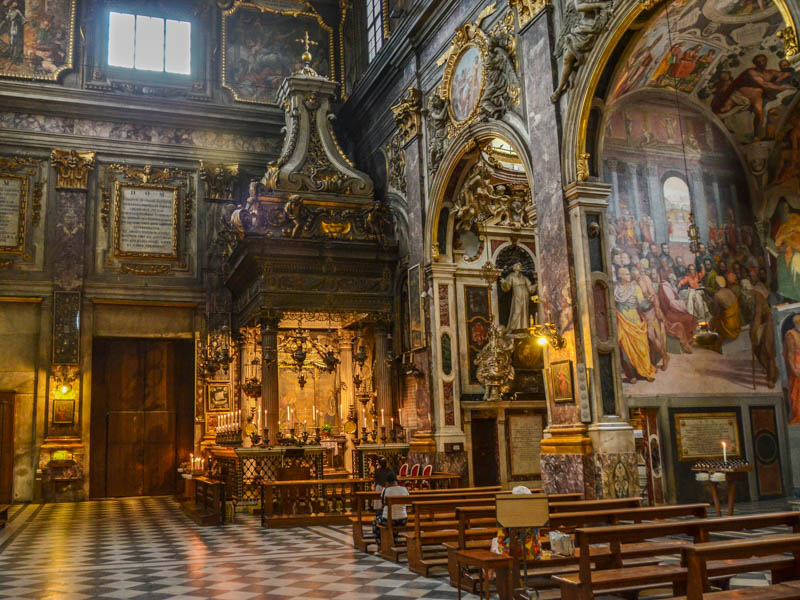
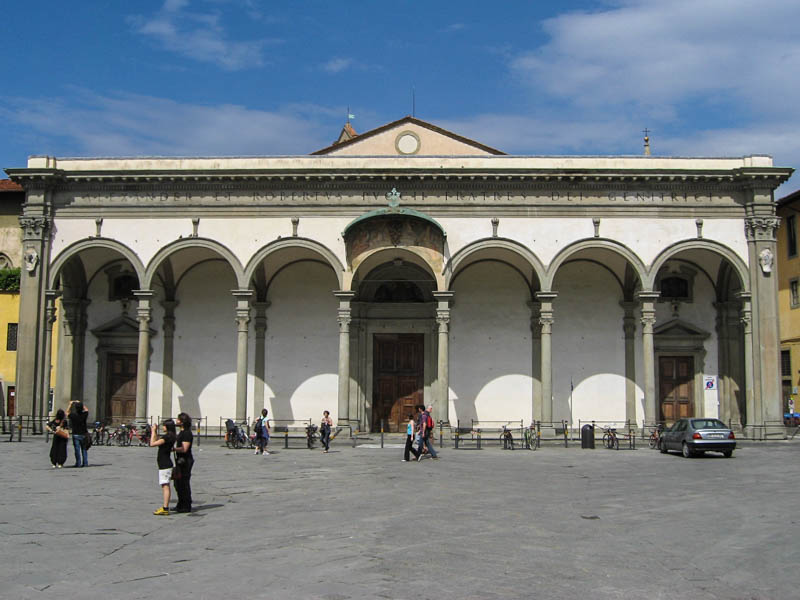
Hardly anyone ever visits SS. Annunziata, and I can never figure out why.
Founded in 1250, this church near the northern edge of the tourist center, anchoring a lovely square lined by loggias (including Brunelleschi's famous Ospedale degli Innocenti), was rebuilt in 1444-81 by Michelozzo and completed by Leon Battista Alberti, two of the greatest architects of the Renaissance.
It was decorated by some of the most important artists of the High Renaissance—especially its Mannerist offshoot (artists who were inspired by the twisting figures and offbeat pastel palette pioneered by Michelangelo).
It also serves as the burial place for many noted Renaissance artists—none of the über-famous early ones, but a whole passel of later second tier greats, including the painters Andrea del Sarto, Pontormo, and Franciabigio and the sculptors Giambologna, Cellini, and Baldinelli.
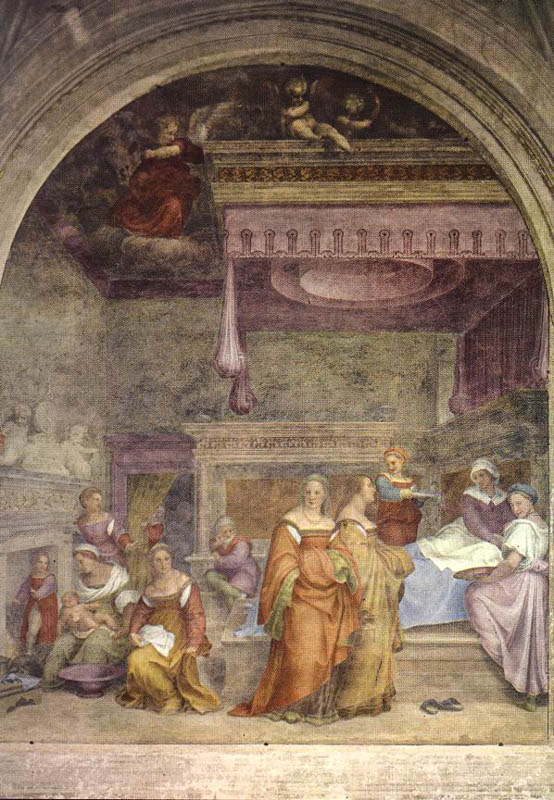
The great art starts even before you get inside, with frescoes (somewhat damaged by the elements; now covered by a skylight) on the walls of the entrance cloister by those Mannerists.
Walking counterclockwise and starting on the right, the first image is Rosso Fiorentino's Assumption, a Visitation by Pontormo, and a Marriage of the Virgin by Franciabigio.
Beyond the marble Madonna and Child (perhaps by Michelozzo himself) are two corner frescoes by Andrea del Sarto: a masterful Birth of the Virgin and a damaged Arrival of the Magi (del Sarto stuck self-portrait in the right corner of that one; he's the dude in the blue hat who is looking out at you).
To the left of the door, the fresco parade picks up again with a ruinous Nativity by Alesso Baldovinetti. The rest of the frescoes tell the life of the obscure San Filippo Benizzi, starting with one by Cosimo Rosselli, but all the rest are by Andrea del Sarto.
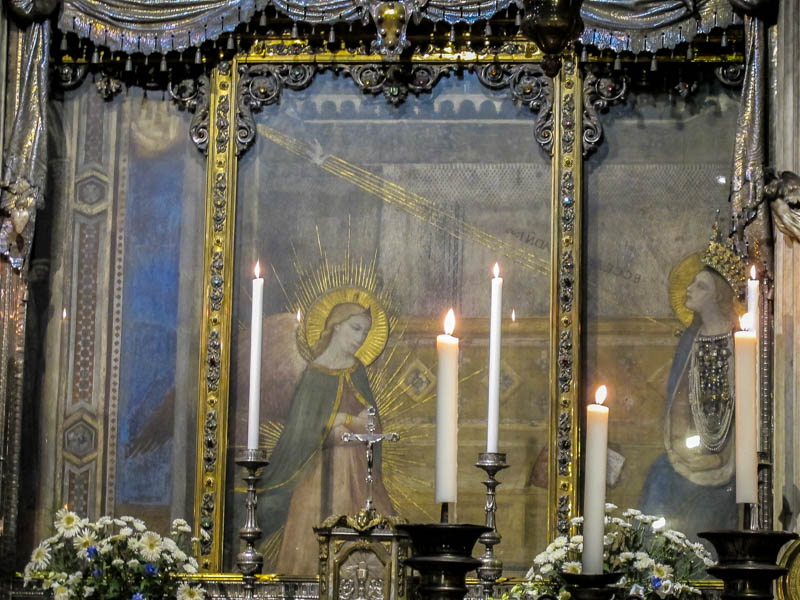
The inside of SS Annunziata is dark and somber, and overly baroque, but still pretty cool.
Look to the left as you enter Santissima Annunziata for a canopied tabernacle by Michelozzo that is completely slathered in ex votos, candles, and hanging lamps by Florentines keen on venerating the tiny painting of Annunciation inside.
This was supposedly painted in the 1300s by Brother Bartolomeo, a simple monk who just couldn't get the Virgin Mary's face right, so he left it blank and lay down for a nap. Upon awakening, he found that an angel had snuck in and painted the face for him.
The mountain of flowers in front of the famous tabernacle? Florentine brides traditionally visit this shrine immediately after their weddings to leave the bridal bouquets at the foot of the miraculous Madonna. This will ensure a good marriage.
Along the left side of the church are a series of fine chapels, the first two with frescoes by Andrea del Castagno, then a chapel with some Alessandro Allori copies of Michelangelo's Sistine Last Judgment (though adopted by and trained by Bronzino—and a great defender of Bronzino's legacy—Allori always also had a soft spot for that earlier Florentine master, Michelangelo), and in the fourth chapel is an Assumption by early Renaissance master (and Raphael teacher) Perugino.
Cross the church to the right transept. There's a processional cross by Castagno again, and a small chapel in which the sculptor Bandinelli is buried, decorated with his carving of Nicodemus (actually a self-portrait) helping lower Christ off the cross. Up above is the second oldest church organ in Italy, designed by Domenico di Lorenzo da Lucca in 1509–21.
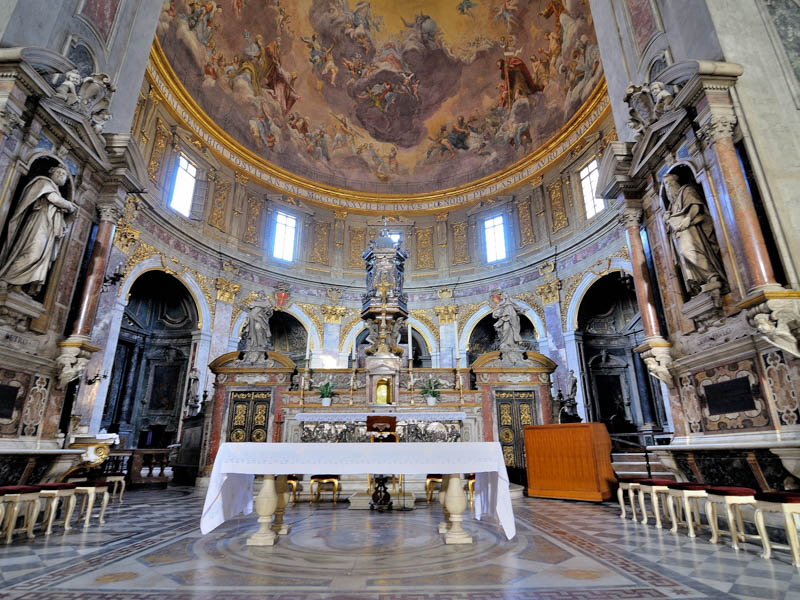
The decahedronal Tribune is a trip, a masterful piece of architecture by that cross-generational tag-team of Michelozzo and Alberti that took its inspiration from Classical models of rotundas and triumphal arches.
It is ringed by eight round chapels (and a square one at the back); the most interesting are those along the left side, starting with the first chapel and Alessandro Allori (the Birth of Mary) and his son, Cristofano Allori (four Miracles of Beato Manetti, one of the church's founders). Third chapel on the left has a Madonna and Saints by Perugino; the next a Resurrection by Bronzino.
The square chapel at the very back of the Tribune was designed by the late Renaissance sculptor Giambologna to serve as his own tomb. He did the bronze Crucifix and the panels; his students did the other statues. The lovely Gothic Madonna altarpiece is by Bernardo Daddi.
As you exit the Tribune, look to the outside base of the triumphal arch for the simple burial slab of the artist Andrea del Sarto (it's right below the statue of St. Peter).
(This isn't always open, but: as you exit the Tribune, turn right to head into the left transept, then right again to enter the Sacristy, designed largely by Michelozzo—who also did the terracotta statue of John the Baptists in the chapel at the far end.)
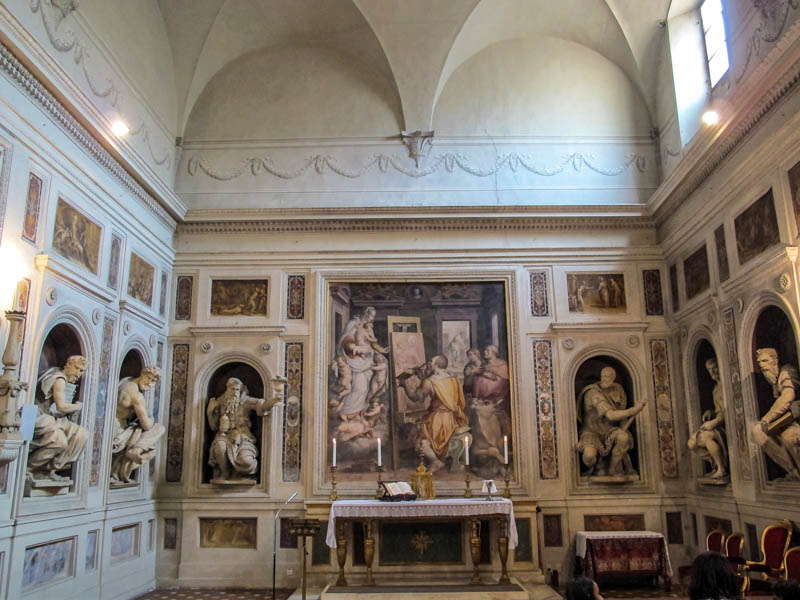
In the left transept, on the south wall, above a door, is a beautiful lunette painting by Andrea del Sarto of the Madonna del Sacco (a version of the Rest on the Flight from Egypt in which Joseph is leaning on the titular sack).
Through the door beneath it you can enter the Chiostro dei Morti, lined by funerary slabs and still more late Renaissance/early baroque frescoes wedged up in the lunettes.
Off the north side of the cloister is the Cappella San Luca, or Chapel of St. Luke, Evangelist and supposed artist and therefore the patron saint of painters—which probably explains why so many of them are buried under it, including Pontormo, Cellini, and Franciabigio. (The chapel holds a special mass for artists on St. Luke's Day, October 18.)
The chapel itself contains a Crucifix carved by Antonio da Sangallo as you enter, a Trinity by Alessandro Allori, a detached frescoes of the Madonna and Saints by Pontormo, an Allegory of Architecture by Santi di Tito, and a ceiling fresco of The Vision of St. Bernard by Luca Giordano.
On the altar is a painting by Giorgio Vasari of St. Luke Painting the Madonna that is amazingly self-aggrandizing, even for a genius self-promoter like Vasari, in which Vasari painted his own self-portrait as the face of St. Luke.
Piazza SS. Annunziata
tel. +39-055-266-181
annunziata.xoom.it
Daily 7:30am–12:30pm and 4–6:30pm (Sun also 8:45–9:45pm)
Free
Bus: 6, 14, 19, 23, 31
Hop-on/hop-off: Piazza Libertà Viale Matteotti (C), Libertà (A, B); Independenza (B)
Planning your day: The church really only takes about 20 minutes to wander, 30–45 if you're really into Mannerists and want to study the works.
Take a guided tour of Chiesa della SS. Annunziata with one of our partners:
You can attend mass Sundays at 7am, 8:30am, 10am, 11:30am, 1pm, 6pm, and 9pm. Mon–Fri mass is held hourly from 7am to noon and 6pm; Saturdays, there is a mass at 6pm.
Share this page
Search ReidsItaly.com
Daily 7:30am–12:30pm and 4–6:30pm (Sun also 8:45–9:45pm)
Free
Bus: 6, 14, 19, 23, 31
Hop-on/hop-off: Piazza Libertà Viale Matteotti (C), Libertà (A, B); Independenza (B)